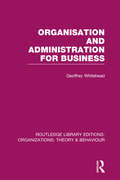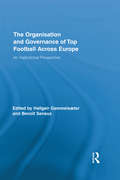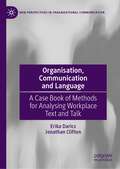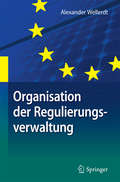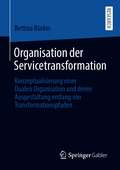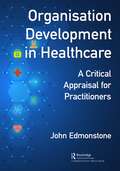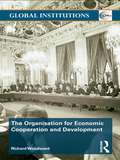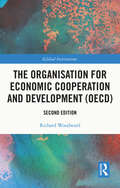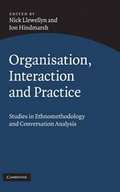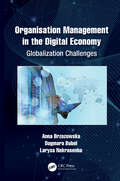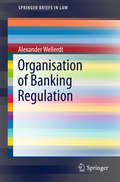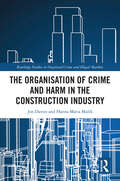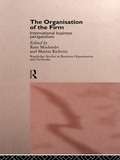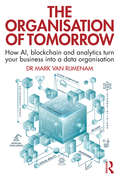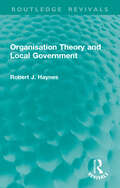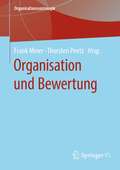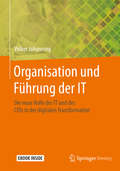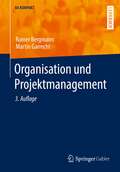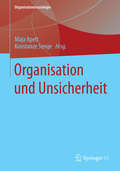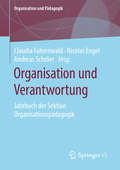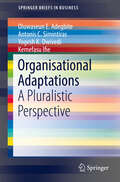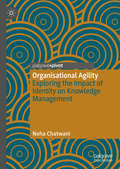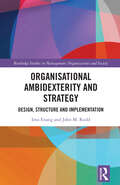- Table View
- List View
Organisation and Administration for Business: Organizations: Organisation And Administration For Business (Routledge Library Editions: Organizations)
by Geoffrey WhiteheadThis book provides a comprehensive introduction to business organisation and administration. Written in a straightforward, readable style this textbook covers all the major aspects of the subject. Starting with the organisational background it goes on to cover the functions of the important departments within the firm, the role of the administrative officer, and other areas of knowledge vital to the smooth running of a business. There are self-assessment questions at the end of each section, past exam questions, study and exam tips and a full index.
The Organisation and Governance of Top Football Across Europe: An Institutional Perspective (Routledge Research in Sport, Culture and Society)
by Hallgeir Gammelsæter BenoîtThis book aims to provide an extensive overview of how football is organized and managed on a European level and in individual European countries, and to account for the evolution of the national, international and transnational management of football over the last decades.
Organisation, Communication and Language: A Case Book of Methods for Analysing Workplace Text and Talk (New Perspectives in Organizational Communication)
by Erika Darics Jonathan CliftonThis book showcases various methodological approaches to the analysis of organizational talk and text. Arguing that organizations are discursive constructions that are communicatively constituted, the authors use the analysis of transcripts of audio-recordings of naturally-occurring workplace talk and authentic written texts to demonstrate what applied linguistics has to offer to scholarly research into organizations as well as management practice and training. The authors discuss the theoretical underpinnings of discursive approaches to the role language in the communicative constitution of organization, and then each chapter focuses on one particular analytical approach. The chapters cover conversation analysis; membership categorization analysis, positioning theory; ventriloquism; metaphor analysis; and metadiscourse analysis and computer-mediated discourse analysis. Consequently, this interdisciplinary work presents a number of methods that allow researchers unfamiliar with fine-grained linguistic analyses of naturally-occurring talk and text to explore ways of adding to their repertoire of research skills.
Organisation der Regulierungsverwaltung: Am Beispiel Der Deutschen Und Unionalen Energieverwaltung
by Alexander WellerdtDieses Buch enthält eine detailreiche Untersuchung von Handlungsformen und Entscheidungsverfahren deutscher und europäischer Regulierungsakteure im Energiebinnenmarkt. Ausgehend von der Bundesnetzagentur wird insbesondere die Zusammenarbeit mit anderen nationalen Regulierungsbehörden, der Agency for the Cooperation of Energy Regulators (ACER) und der Europäischen Kommission hinsichtlich Organisation und Verfahren herausgearbeitet. Anhand einer wissenschaftlichen Einordnung der Praxisinstrumente nach Handlungsformen, Rechtswirkungen und Rechtsschutzintensität werden Modelltypen entwickelt, die das Zusammenspiel von Organisationsformen und Entscheidungsverfahren im europäischen Regulierungsverbund aufzeigen. Dieses Buch deckt Spannungen im europäischen Energiebinnenmarkt auf, indem es sich nicht auf die Feststellung rechtlicher Unstimmigkeiten im Regulierungsverbund beschränkt, sondern aktuelle Praxisprobleme aufgreift und zukünftige Entwicklungen durch das Vierte Energiebinnenmarktpaket antizipiert.
Organisation der Servicetransformation: Konzeptualisierung einer Dualen Organisation und deren Ausgestaltung entlang von Transformationspfaden
by Bettina BürkinDie hohe Bedeutung von Dienstleistungen für das Leistungsangebot produktorientierter Unternehmen erfordert eine grundlegende strategische Veränderung dieser Unternehmen, mit Konsequenzen für ihren organisatorischen und strukturellen Aufbau. Bettina Bürkin entwickelt in dieser Arbeit ein ganzheitliches Transformationsmodell mit dem Schwerpunkt der Dualität für diese Servicetransformation und leistet so einen konzeptionellen und praktischen Beitrag zur Umsetzung dienstleistungsorientierter Strategien in produktorientierten Unternehmen. Dazu findet eine intensive Auseinandersetzung mit den konzeptionellen Grundlagen und den Besonderheiten der Servicetransformation statt. Des Weiteren werden im Rahmen einer organisationstheoretischen Analyse die Kontingenztheorie, Ambidextrie und Dualitätstheorie im Hinblick auf ihren theoretischen Erklärungsbeitrag für die Duale Organisation für die Servicetransformation bewertet. Die Autorin zeigt weiterhin anhand zweier idealtypischer Transformationspfade die Anwendung des Transformationsmodells für unterschiedliche Organisationsformen und -kontexte. Auf Basis ihrer konzeptionellen Arbeit und den Ergebnissen einer qualitativen Untersuchung werden schließlich Handlungsempfehlungen für die reflektierte, situationsspezifische Vorbereitung und Anwendung des Transformationsmodells gegeben.
Organisation Development in Healthcare: A Critical Appraisal for OD Practitioners
by John EdmonstoneOrganisational development (OD) as a practice involves an ongoing, systematic process of implementing effective organisational change. OD is both a field of applied science focused on understanding and managing organisational change and a field of scientific study and inquiry. It is interdisciplinary in nature and draws on sociology, psychology, particularly industrial and organisational psychology, and theories of motivation, learning, and personality. Organisation Development in Healthcare: A Critical Appraisal for Practitioners provides both an overview of the evolution of OD in healthcare as a field of practice and as a challenge to its future development. It examines the underlying assumptions behind OD and tracks its historical growth in healthcare, with special attention devoted to the UK’s National Health Service. The unusual nature of healthcare organisations delivering human services through the work of professionals who are subject to emotional labor and are addressing society’s wicked problems provides a unique context. A range of challenges for healthcare OD are identified, including questions of conformists or deviant innovation; organisations as machines or systems; hierarchy versus democracy; the importance of power and emotion and possible future ways forward for healthcare OD are suggested. Examples and short case studies from both the UK and the US to illustrate the benefits of OD are included.
The Organisation for Economic Co-operation and Development (Global Institutions)
by Richard WoodwardThe Organisation for Economic Co-operation and Development (OECD) is one of the least written about and least understood of our major global institutions. This new book builds a well-rounded understanding of this crucial, though often neglected, institution, with a range of clearly written chapters that: outline its origins and evolution, bringing its story fully up-to-date present a clear framework for understanding the OECD set the institution within the broader context of global governance outline key criticisms and debates evaluate its future prospects. Given the immense challenges facing humanity at the start of the 21st century, the need for the OECD as a venue where the world’s leading states can discuss, on an informal and ongoing basis, the conundrums of globalization has never been greater. The clarity and rigour of these chapters cut through the layers of misunderstanding and misconception that surround the OECD, often dismissed as a ‘rich-man’s club’, ‘a think-tank’ and ‘a consultative forum’. This new book dismantles these labels to provide a holistic understanding of the organization. This concise and accessible introduction is essential reading for all students of international relations, politics and world history and affairs.
The Organisation for Economic Co-operation and Development (Global Institutions)
by Richard WoodwardCelebrating its 60th anniversary in 2021, the Organisation for Economic Cooperation and Development (OECD) is routinely heralded as one of the leading organs of global governance, yet it remains one of the least written about and least well understood of our major global institutions. This fully revised and updated second edition builds a well-rounded understanding of this crucial, though often neglected, institution. A range of clearly written chapters chart the origins and evolution of the organization, comprehend its influence, examine its current agenda, and evaluate its future prospects. Rather than the simplified characterizations of the OECD as a “rich-country’s club” or “think tank,” this book suggests that truly understanding the OECD and its significance to global governance requires it to be conceived as the entity it truly is: an international organization. New to this edition: Outlines the OECD’s origins and evolution, bringing its story fully up to date Considers the ‘OECD way’ of working, including the peer review process Examines competing views of the OECD’s influence over global governance Evaluates the OECD reform and the organization’s future prospects This concise introduction continues to be vital reading for all students of international relations, politics and world history and affairs.
Organisation, Interaction and Practice
by Nick Llewellyn Jon HindmarshEthnomethodology has an elusive relationship with organisation studies. The ethnomethodological work of Harold Garfinkel, and the allied conversation analytic work of Harvey Sacks, is often cited and yet empirical contributions informed by ethnomethodology and conversation analysis remain rare. Organisation studies clearly has a lot to say about work but this is normally related to some broader set of social, economic and political issues. Rarely, if ever, does this research involve an analysis of the mundane and practical details of what actual work consists of. This book acts as an evidence-based corrective by showing how research based on ethnomethodology and conversation analysis can contribute to key issues and debates in organisation studies. Drawing on audio/video recordings from a diverse range of work settings, a team of leading scholars present a series of empirical studies that illustrate the importance of paying attention to the real-time achievement of organisational processes and practices.
Organisation Management in the Digital Economy: Globalization Challenges
by Anna Brzozowska Dagmara Bubel Larysa NekrasenkoThis book highlights the essence of information technology in the modern digital world in relation to improvements and threats to organisations and e-business in the era of the digital economy. Rapid IT development has created modern business proposals such as digital and virtual currencies, crowdfunding, peer-to-peer lending, mobile banking, online investing and new payment systems. This allows organisations and firms to increase competitiveness by using financial products and services, thus increasing their value. Information technology users receive significant timesaving and a choice of investment options. At the same time, there is a new challenge for regulators who must monitor how this or that technology affects the financial sector. The authors have collected and systematised information on the models of using information technology in e-business as well as issues of applying information technology in smart organisations and public institutions. The book addresses the issues of risk management in organizations and the problems of personal and social risks resulting from the use of information technology. In addition, the book presents a review of e-commerce sectors and models as well as e-commerce tools, international payment systems and modern money systems. Risks, threats and security rules for using banking services, e-commerce and payment systems are reviewed and systematised.
Organisation of Banking Regulation
by Alexander WellerdtThis book illustrates the interaction of banking regulators and discusses with it related legal and economic challenges. First, the importance of administrative organisations for the implementation of regulatory law towards banks and financial institutions is shown. On this basis five model types of administrative organisations in the field of banking regulation are derived. Thereby, banking regulators can be classified due to their influence on regulatory decisions. Their influence runs from preparation across enforcement to control of regulatory decisions. In particular, the cooperation of the European Central Bank with national banking regulators is analysed. Finally, the main legal and economic arguments of Banking Regulation in the Economic and Monetary Union are discussed.
The Organisation of Crime and Harm in the Construction Industry (Routledge Studies in Organised Crime)
by Jon Davies Hanna MalikDrawing on empirical work and secondary analysis from the UK and Finnish construction industries, this book contributes a deep-rooted analysis of construction industry harms that originate from corporate-industrialstate processes.The UK context arguably represents a classic ‘neoliberal’ system categorised by privatisation of services and minimal regulation, whereas Finland broadly provides a ‘social democratic’ alternative with its relatively strong national regulation and public sector oversight of industry. These concepts interlink strongly with the notion of state-corporate crime, since this perspective shifts attention away from individualistic explanations for crime and harm towards symbiosis between states and corporations. This book argues that existing explanations based on organised crime and individual ‘rogues’ are insufficient to account for the wider range and subtlety of harms that occur in construction, and therefore offers a unique perspective into organisational, industry, and state dynamics in this sector.An accessible and compelling read, this book will appeal to students and scholars of criminology, sociology, organized crime, and those interested in harms in the construction industry.
The Organisation of the Firm: International Business Perspectives (Routledge Studies in Business Organizations and Networks #No.6)
by Ram Mudambi Martin RickettsIn recent years there has been a growth in work on the organization of the firm. The same period has also seen a corresponding rise in literature dealing with the organization of the multinational firm, but the two literatures have developed quite separately, even though insights from each have much to offer the other. This unique collection of essays from respected academics aims to bridge this gap, addressing questions of the theory of the firm and international business.The material is presented in three sections:* The first section deals with theoretical issues underpinning multinational enterprise. These are the issues of information, re-engineering and change management and international trade.* The second section concentrates on the inter-firm relationships of multinationals, assessing the interplay of co-operation and adversarial behaviour.* The third section deals with applications of the principles presented in the first two sections. The applications concern the defence equipment industry, the world automobile industry and corporate governance under European Union Regulations.The Organisation of the Firm is aimed at researchers and students in the field of international business, and is likely to appeal to advanced undergraduates and postgraduates, as well as academics.
The Organisation of Tomorrow: How AI, blockchain and analytics turn your business into a data organisation
by Mark Van RijmenamThe Organisation of Tomorrow presents a new model of doing business and explains how big data analytics, blockchain and artificial intelligence force us to rethink existing business models and develop organisations that will be ready for human-machine interactions. It also asks us to consider the impacts of these emerging information technologies on people and society. Big data analytics empowers consumers and employees. This can result in an open strategy and a better understanding of the changing environment. Blockchain enables peer-to-peer collaboration and trustless interactions governed by cryptography and smart contracts. Meanwhile, artificial intelligence allows for new and different levels of intensity and involvement among human and artificial actors. With that, new modes of organising are emerging: where technology facilitates collaboration between stakeholders; and where human-to-human interactions are increasingly replaced with human-to-machine and even machine-to-machine interactions. This book offers dozens of examples of industry leaders such as Walmart, Telstra, Alibaba, Microsoft and T-Mobile, before presenting the D2 + A2 model – a new model to help organisations datafy their business, distribute their data, analyse it for insights and automate processes and customer touchpoints to be ready for the data-driven and exponentially-changing society that is upon us This book offers governments, professional services, manufacturing, finance, retail and other industries a clear approach for how to develop products and services that are ready for the twenty-first century. It is a must-read for every organisation that wants to remain competitive in our fast-changing world.
Organisation Studies and Human Resource Management: An Educator's Handbook
by Kate BlackThis book advances educational understanding and practice in Organisation Studies and Human Resource Management (OSHRM). It develops new theoretical perspectives on learning in OSHRM and introduces and evaluates a range of educational approaches, methods and techniques to advance teaching and assessment and student learning in the field. Chapters are evidence-based and provide practical advice for enhancing the effectiveness of OSHRM programmes and courses in universities, colleges and human resource development settings globally. With contributions from leading educators in OSHRM, the book both advances understanding and provides practical guidance for the design of programmes, courses and classes. Importantly, it illustrates innovative classroom and virtual learning experiences that will secure student engagement; cultivate critical and creative thinking; and enhance students’ employability, leadership and enterprise capabilities. A distinctive contribution of the book lies in the inclusion of student viewpoints on the understandings and educational advances proposed by the authors. Significantly, the book demonstrates how recent changes affecting higher education, such as globalisation, mass participation and marketisation, and, most recently, the pandemic crisis, can be embraced as opportunities to advance both educational understanding and educational policy and practice in OSHRM. This book will be invaluable for university educators internationally in the fields of OSHRM and for HR developers working in management and leadership development, and the book has relevance to both groups whatever their career stage, from absolute beginners through to advanced practitioners.
Organisation Theory and Local Government (Routledge Revivals)
by Robert J. HaynesOriginally published in 1980, this book provides an analysis and assessment of events in local government management during the late 20th Century set within an overall conceptual framework of organisation theory. The book fills the gap between theoretical prescription and practical management application. The analysis focuses on three areas of organisation design and functioning – the structural, the procedural and the cultural. In each of these areas the interrelationship between broad theoretical prescriptions and the actual management innovations introduced in local authorities is examined. A major portion of the book is devoted to an assessment of the importance of behavioural/cultural factors in the introduction and assimilation (or rejection) of managerial change, an aspect of organisational functioning which was neglected in the literature on local government management.
Organisation und Bewertung (Organisationssoziologie)
by Frank Meier Thorsten PeetzOrganisationen spielen für viele Bewertungsprozesse eine entscheidende, aber oft übersehene Rolle: Sie geben den Kontext ab, in dem Bewertungen vollzogen werden, sie produzieren und kommunizieren Bewertungen und werden schließlich auch selbst regelmäßig bewertet, evaluiert, geratet und gerankt. Die Beiträge des Bandes verknüpfen systematisch Ansätze aus Organisationsforschung und Valuation Studies und eröffnen dadurch einen dezidiert organisationssoziologischen Blick auf Phänomene des Bewertens, Vermessens, Kategorisierens und Vergleichens in, von und durch Organisationen.
Organisation und Führung der IT: Die neue Rolle der IT und des CIOs in der digitalen Transformation
by Volker JohanningDas Buch zeigt praxisnah wie sich IT-Organisationen optimal aufstellen müssen in dieser sich dynamisch wandelnden Welt und was dies für die Führung dieser immer wichtiger werdenden IT bedeutet. Darüber hinaus wird das Thema Führung einer IT-Organisation näher beleuchtet: Was ist die Rolle und was sind die Führungsaufgaben eines CIOs? Wie und mit welchen Mitteln kann eine IT-Organisation am besten gesteuert werden? Wie können komplexe Veränderungsprozesse und Transformationen geführt werden? Somit bietet das Buch eine praxisorientierte Anleitung für die Organisationsänderung oder Reorganisation der IT mit vielen Tipps zu Change-Management, Führung sowie agilen Methoden und Ansätzen in der neuen IT-Organisation.
Organisation und Führung in turbulenten Zeiten: Entwurf und Implementierung unter Verwendung des 3-P-Modells
by Peter Wollmann Frank Kühn Michael Kempf Reto PüringerDieses Buch knüpft an die erfolgreiche Entwicklung des Drei-Säulen-Modells (3-P-Modell) der Autoren für die Organisation und Führung in disruptiven Zeiten an. Der Schwerpunkt liegt darauf, dem Leser bei der Umsetzung des Modells zu helfen und eine Vielzahl von Anwendungsfällen für diese VUCA-Zeiten (Volatilität, Ungewissheit, Komplexität und Mehrdeutigkeit), einschließlich globaler Krisen wie der COVID-19-Pandemie, zu liefern. Das Buch deckt ein breites Spektrum von Organisationen ab: privater und öffentlicher Sektor, Nichtregierungsorganisationen, lokale und globale Regierungsinstitutionen, globale Organisationen wie die UNO usw. Darüber hinaus wird aufgezeigt, wie das 3-P-Modell auf Herausforderungen bei der Organisationsgestaltung, dem Management und der Führung angewendet werden kann.
Organisation und Projektmanagement (BA KOMPAKT)
by Rainer Bergmann Martin GarrechtAnschaulich und praxisnah zeigen die Autoren in diesem Lehrbuch, wie Organisationen funktionieren, wie sie gestaltet werden können und wie Projekte gemanagt werden: von der Aufbauorganisation und der Gestaltung von Prozessen über die Organisationskultur bis hin zur Arbeit in Projektteams. Warum Unternehmen heute so unterschiedlich gestaltet sind, zeigt ein Überblick über die Organisationstheorien von der wissenschaftlichen Betriebsführung und ihrer aktuellen Bedeutung im digitalen Taylorismus bis zu aktuellen Managementkonzepten (z. B. Organisation in Netzwerken, Shared Service Centern, Selbstorganisation oder Change Management) und deren kritischer Würdigung vor dem Hintergrund der Entwicklung von Managementmoden.Anschauliche Fallstudien und Praxisbeispiele zu jedem Themenblock regen die Diskussion im Anwendungszusammenhang an. Das Buch deckt vollständig die Anforderungen ab, die für das Modul "Organisation und Projektmanagement" in Bachelor-Studiengängen gestellt werden.Die dritte Auflage wurde um diverse Abschnitte zu neuen Managementkonzepten (u. a. agiles Projektmanagement, flache Hierarchien, Holakratie, evolutionäre Organisation) und um zahlreiche Praxis- und Fallbeispiele erweitert sowie umfassend aktualisiert und ergänzt.
Organisation und Unsicherheit
by Maja Apelt Konstanze SengeDas Buch ,,Organisation und Unsicherheit" geht der Frage nach, wie Organisationen in der Gegenwart auf Unsicherheiten reagieren. Diese Unsicherheiten können organisationsintern erzeugt werden oder aus der Organisationsumwelt resultieren. Aus unterschiedlichen theoretischen Perspektiven und anhand verschiedener empirischer Analysen zu Jugendämtern, Bildungseinrichtungen, High Reliability Organisationen und Organisationen des Finanzmarktes u. a. m. wird gezeigt, welche Konsequenzen sich aus zunehmenden Unsicherheiten für das Handeln in Organisationen und die Beziehungen zwischen Organisationen und Umwelt ergeben. Versuche, Unsicherheit zu vermeiden oder zu beseitigen, führen dabei - wie viele der Beiträge zeigen - zu neuen Unsicherheiten.
Organisation und Verantwortung: Jahrbuch der Sektion Organisationspädagogik (Organisation und Pädagogik #27)
by Claudia Fahrenwald Nicolas Engel Andreas SchröerDas Jahrbuch möchte in theoretischer, empirischer und pragmatischer Perspektive zur Klärung einer (organisations-)pädagogischen Verhältnisbestimmung von Organisation und Verantwortung beitragen. Im Rekurs auf die internationale und interdisziplinäre Diskussion zum Begriff der Verantwortung in seiner ethischen, gesellschaftlichen, politischen und pädagogischen Dimension werden organisationstheoretische Fragen und organisationspädagogische Heraus-forderungen bearbeitet. Die Beiträge beschäftigen sich mit dem Thema im Hinblick auf Rolle, Funktion(en) und Bedeutung von Verantwortung in, von und zwischen Organisationen als zentrale Träger des kulturellen und gesellschaftlichen Wandels. Über das Schwerpunktthema hinaus enthält das Buch weitere Beiträge zu aktuellen organisationspädagogischen Fragestellungen.
Organisational Adaptations: A Pluralistic Perspective (SpringerBriefs in Business)
by Oluwaseun E. Adegbite Antonis C. Simintiras Yogesh K. Dwivedi Kemefasu IfieThis book explores how enterprises adapt to challenges in their business environments. It focuses on the critical elements within organisations that every executive must address in order to remain competitive. It takes a pluralist approach in trying to broaden our knowledge on organisational adaptations. It also offers an exploratory delve into existing literature of organisational study. This is biased for content, context and process framework and processual analytic approach in order to identify, determine, understand the intricacies of adaptations going on in various business organisations. The book also includes a case study of how Kodak and Fujifilm responded to digitalisation of photographic film industry, which is an example of major adaptation change. Many global brands are often contending with similar issues and real life challenges. Simply put, today’s business environment demands a new way of doing business that challenges brand’s existing core business philosophy.Organisations are ‘individual’ entities in their own rights. Businesses have devised ways of surviving their environments. They do this by downsizing, merger and acquisition, business ecosystems, other forms of collaborations and strategic alliances. While this is true, current research works into generic predictors and/or concepts that enhance the transformation process are scarce. It is particularly important to align the theories and concepts of organisational adaptations with realities in the business environment. This book delves deep and explains adaptations in organisations, but also offers insight for how executives can adapt and thrive in their dynamic business environments.
Organisational Agility: Exploring the Impact of Identity on Knowledge Management
by Neha ChatwaniThe agility paradigm suggests that knowledge management is central to an organisations’ capability to proactively anticipate environmental changes and respond to them effectively. This book specifically explores how organisational identity impacts knowledge flows within an organisation, influencing and negotiating its responsiveness. By looking at agility through the identity lens the author takes a cross-disciplinary approach that aims at offering a new and important perspective towards our current understanding of change management and in particular, of the agility model, making this book a valuable resource for students, researchers and practitioners.
Organisational Ambidexterity and Strategy: Design, Structure and Implementation (Routledge Studies in Management, Organizations and Society)
by Imo Enang John M. RuddAcross the last 50 years, there have been increasing studies on Organizational Ambidexterity (OA). However, there has been a disproportionate focus on the theory underpinning OA with less recourse to the implementation of OA. The primary purpose of this book is to close gaps in the understanding of Organizational Ambidexterity Implementation (OAI) and its relationship with organizational performance. It identifies key components crucial for successful OAI, including dynamic capabilities, organizational culture, organizational design and market orientation. The scope encompasses both qualitative and quantitative analysis, investigating the factors that drive or obstruct OAI and assessing performance disparities among organizations. This book is intended for academics, researchers, and professionals interested in corporate strategy with focus on the management of organizational resources and capabilities within organizational structure and design for performance improvement. It serves as a valuable resource for those seeking to understand how organizational culture, dynamic capabilities, market orientation, and design impact the successful implementation of ambidexterity and, consequently, overall organizational performance. Additionally, business leaders and managers can gain insights to help their organizations evaluate and enhance their abilities in these critical areas, ultimately fostering a culture of innovation and efficiency.
